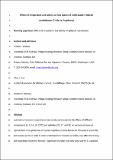Files in this item
Effects of temperature and salinity on four species of northeastern Atlantic scyphistomae (Cnidaria Scyphozoa)
Item metadata
| dc.contributor.author | Widmer, Chad L. | |
| dc.contributor.author | Fox, Clive J. | |
| dc.contributor.author | Brierley, Andrew S. | |
| dc.date.accessioned | 2017-11-10T00:33:21Z | |
| dc.date.available | 2017-11-10T00:33:21Z | |
| dc.date.issued | 2016-11-09 | |
| dc.identifier | 247933288 | |
| dc.identifier | 50a89e21-0fc0-45ce-bfe2-e48073385a5d | |
| dc.identifier | 84994776817 | |
| dc.identifier | 000388225000007 | |
| dc.identifier.citation | Widmer , C L , Fox , C J & Brierley , A S 2016 , ' Effects of temperature and salinity on four species of northeastern Atlantic scyphistomae (Cnidaria Scyphozoa) ' , Marine Ecology Progress Series , vol. 559 , pp. 73-88 . https://doi.org/10.3354/meps11879 | en |
| dc.identifier.issn | 0171-8630 | |
| dc.identifier.other | ORCID: /0000-0002-6438-6892/work/60427335 | |
| dc.identifier.uri | https://hdl.handle.net/10023/12045 | |
| dc.description | This work was funded by the MASTS pooling initiative (Marine Alliance for Science and Technology for Scotland), and we gratefully acknowledge that support. MASTS is funded by the Scottish Funding Council (grant reference HR09011) and contributing institutions. C.L.W. is also grateful to the US/UK Fulbright Commission and the University of St Andrews for their financial support. | en |
| dc.description.abstract | Laboratory incubation experiments were conducted to examine the effects of different temperatures (4, 9, 14, 19, 23°C) and salinities (21, 27, 34) on survival and asexual reproduction of scyphistomae of Cyanea capillata, C. lamarckii, Chrysaora hysoscella, and Aurelia aurita in order to better understand how climate variability may affect the timing and magnitude of jellyfish blooms. Significant mortality was observed only for C. capillata and Ch. hysoscella at the highest and lowest temperatures, respectively, but temperature and salinity significantly affected the asexual reproductive output for all species. As temperature increased, production rates of podocysts increased and, if produced, progeny scyphistomae by side budding also increased. However, strobilation rates, and therefore the mean number of ephyrae produced, decreased when scyphistomae were exposed to elevated temperatures. These results provide a mechanistic explanation for why ephyrae of these species tend to be produced during colder periods of the year whilst summer and early autumn are probably important periods for increasing the numbers of scyphistomae in natural populations. | |
| dc.format.extent | 16 | |
| dc.format.extent | 652496 | |
| dc.language.iso | eng | |
| dc.relation.ispartof | Marine Ecology Progress Series | en |
| dc.subject | Ephyra | en |
| dc.subject | Jellyfish | en |
| dc.subject | Life cycle | en |
| dc.subject | Salinity | en |
| dc.subject | Scyphistoma | en |
| dc.subject | Strobila | en |
| dc.subject | Temperature | en |
| dc.subject | QH301 Biology | en |
| dc.subject | Ecology, Evolution, Behavior and Systematics | en |
| dc.subject | Ecology | en |
| dc.subject | Aquatic Science | en |
| dc.subject | SDG 13 - Climate Action | en |
| dc.subject.lcc | QH301 | en |
| dc.title | Effects of temperature and salinity on four species of northeastern Atlantic scyphistomae (Cnidaria Scyphozoa) | en |
| dc.type | Journal article | en |
| dc.contributor.institution | University of St Andrews. School of Biology | en |
| dc.contributor.institution | University of St Andrews. Marine Alliance for Science & Technology Scotland | en |
| dc.contributor.institution | University of St Andrews. Scottish Oceans Institute | en |
| dc.contributor.institution | University of St Andrews. Centre for Research into Ecological & Environmental Modelling | en |
| dc.contributor.institution | University of St Andrews. Pelagic Ecology Research Group | en |
| dc.identifier.doi | 10.3354/meps11879 | |
| dc.description.status | Peer reviewed | en |
| dc.date.embargoedUntil | 2017-11-09 |
This item appears in the following Collection(s)
Items in the St Andrews Research Repository are protected by copyright, with all rights reserved, unless otherwise indicated.

